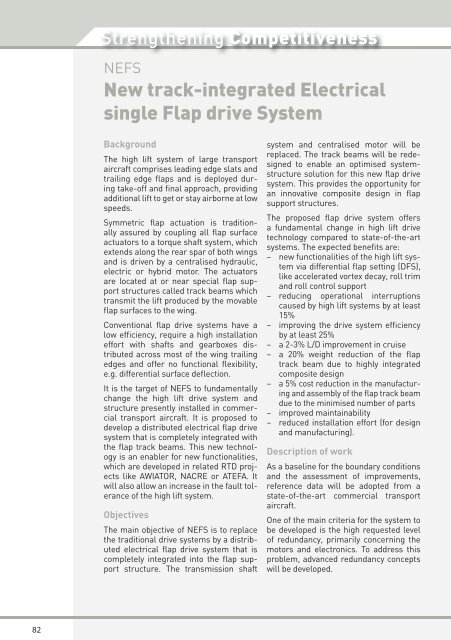Aeronautics Research 2002 - 2006 projects
Aeronautics Research 2002 - 2006 projects
Aeronautics Research 2002 - 2006 projects
You also want an ePaper? Increase the reach of your titles
YUMPU automatically turns print PDFs into web optimized ePapers that Google loves.
82<br />
Strengthening Competitiveness<br />
NEFS<br />
New track-integrated Electrical<br />
single Flap drive System<br />
Background<br />
The high lift system of large transport<br />
aircraft comprises leading edge slats and<br />
trailing edge fl aps and is deployed during<br />
take-off and fi nal approach, providing<br />
additional lift to get or stay airborne at low<br />
speeds.<br />
Symmetric fl ap actuation is traditionally<br />
assured by coupling all fl ap surface<br />
actuators to a torque shaft system, which<br />
extends along the rear spar of both wings<br />
and is driven by a centralised hydraulic,<br />
electric or hybrid motor. The actuators<br />
are located at or near special fl ap support<br />
structures called track beams which<br />
transmit the lift produced by the movable<br />
fl ap surfaces to the wing.<br />
Conventional fl ap drive systems have a<br />
low effi ciency, require a high installation<br />
effort with shafts and gearboxes distributed<br />
across most of the wing trailing<br />
edges and offer no functional fl exibility,<br />
e.g. differential surface defl ection.<br />
It is the target of NEFS to fundamentally<br />
change the high lift drive system and<br />
structure presently installed in commercial<br />
transport aircraft. It is proposed to<br />
develop a distributed electrical fl ap drive<br />
system that is completely integrated with<br />
the fl ap track beams. This new technology<br />
is an enabler for new functionalities,<br />
which are developed in related RTD <strong>projects</strong><br />
like AWIATOR, NACRE or ATEFA. It<br />
will also allow an increase in the fault tolerance<br />
of the high lift system.<br />
system and centralised motor will be<br />
replaced. The track beams will be redesigned<br />
to enable an optimised systemstructure<br />
solution for this new fl ap drive<br />
system. This provides the opportunity for<br />
an innovative composite design in fl ap<br />
support structures.<br />
The proposed fl ap drive system offers<br />
a fundamental change in high lift drive<br />
technology compared to state-of-the-art<br />
systems. The expected benefi ts are:<br />
– new functionalities of the high lift system<br />
via differential fl ap setting (DFS),<br />
like accelerated vortex decay, roll trim<br />
and roll control support<br />
– reducing operational interruptions<br />
caused by high lift systems by at least<br />
15%<br />
– improving the drive system effi ciency<br />
by at least 25%<br />
– a 2-3% L/D improvement in cruise<br />
– a 20% weight reduction of the fl ap<br />
track beam due to highly integrated<br />
composite design<br />
– a 5% cost reduction in the manufacturing<br />
and assembly of the fl ap track beam<br />
due to the minimised number of parts<br />
– improved maintainability<br />
– reduced installation effort (for design<br />
and manufacturing).<br />
Description of work<br />
As a baseline for the boundary conditions<br />
and the assessment of improvements,<br />
reference data will be adopted from a<br />
state-of-the-art commercial transport<br />
aircraft.<br />
Objectives<br />
One of the main criteria for the system to<br />
The main objective of NEFS is to replace be developed is the high requested level<br />
the traditional drive systems by a distrib- of redundancy, primarily concerning the<br />
uted electrical fl ap drive system that is motors and electronics. To address this<br />
completely integrated into the fl ap sup- problem, advanced redundancy concepts<br />
port structure. The transmission shaft will be developed.

















